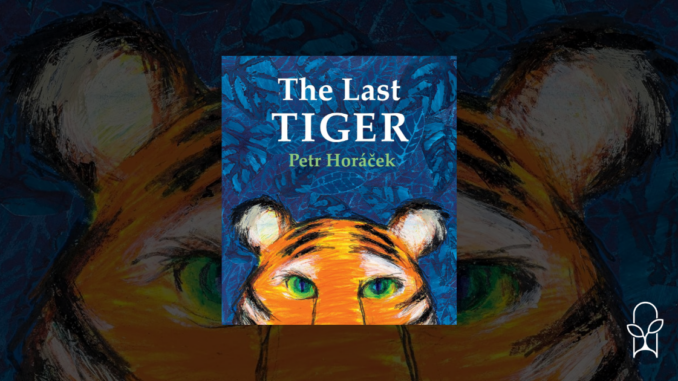
Published by Eerdmans Books for Young Readers on August 25, 2020
Genres: Children's
Buy on Amazon
Goodreads

When hunters invade the jungle, all the animals try to hide—except the tiger. He is strong, proud, and powerful; why should he flee like a bird or a monkey? But the humans are even more fearless than the tiger is, and he soon finds himself in a cage in the city. Will he ever see his home again?
Illustrated in glowing colors, The Last Tiger is a thoughtful fable about the dangers of pride and the value of freedom.
The Last Tiger reads like a forgotten Aesop’s fairy tale. Short, simple, evocative, and with an animal friend as its protagonist, The Last Tiger is a straightforward parable about the danger of pride and the importance of freedom. In the story, the tiger is the king of the jungle (fun fact: despite their nickname, lions actually do not live in jungles). When hunters come to the jungle, the other animals run but the tiger sees no need. The hunters capture the tiger and take him to a zoo—and this is not the well-kept nature preservation type of zoos today, but the animals in barred cages zoos of a century ago. Eventually, the lion loses enough weight that he is able to slip through the bars and back to freedom.
There are some plot holes in the story. Is the jungle and the city so close? Would he be able to escape without being noticed? Is that the subject of a different book? Everything in the story happens simply and matter-of-factly without much conflict or nuance. The message of the hubris of pride and the desire for freedom is singular and overpowering. I think that giving more detail about what a lack of freedom meant would have brought depth to the book. Obviously, this book is meant for kids. What does freedom mean to them? The book never really explains what freedom is, other than not being caged.
I also wonder if books that continue to portray the old-timey stereotype of zoos are helpful—both in the sense of them holding meaning to today’s generation of children and in the sense of promoting wildlife conservation. Zoos today utilize cages, but nothing like the concrete and iron bars of circuses and zoos of a hundred years ago. I would hate for children to get an outdated idea of zoos because of books that utilize an old stereotype.
The strength of The Last Tiger is its illustrations. Petr Horacek uses colors well, filling the entirety of the page with masterful brushstrokes that provide a sense of depth and wonder. Just look at how beautiful the cover is with the dark blue background contrasting with the interlaced orange and yellow of the tiger. Overall, this isn’t my favorite. There’s things I wished the story did better, but I have no complaints at all about the illustrations.
